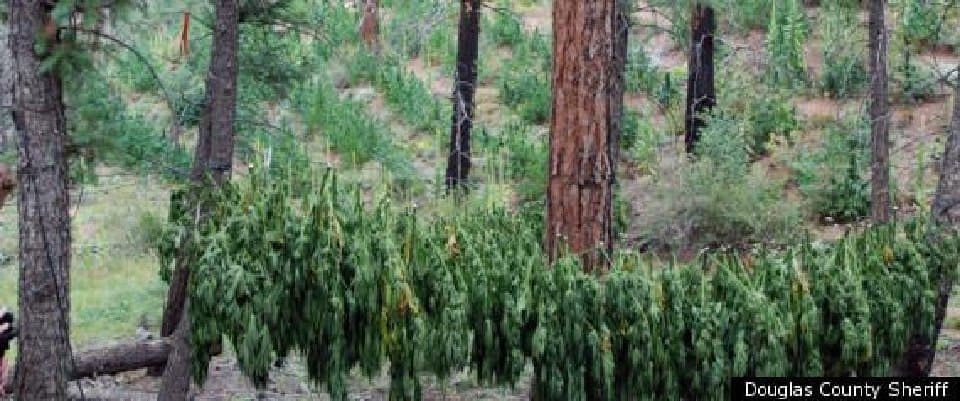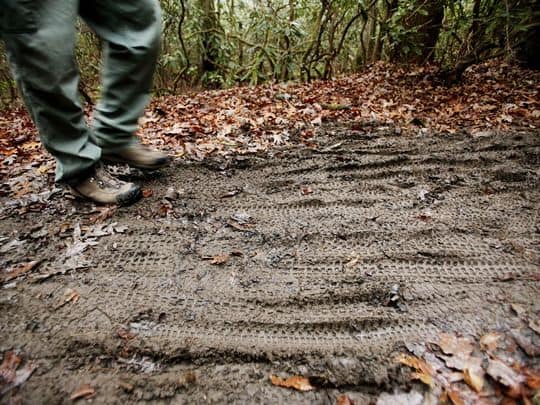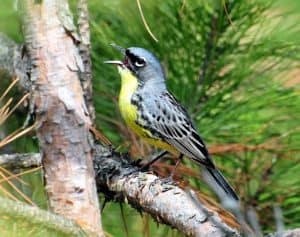A couple of months ago, I reported that several west coast wilderness areas remained closed months after their summer wildfires had gone out. I’m pleased to report that the Forest Service has rescinded some of the closure orders in response to FSEEE’s requests.
Sometimes it takes a lawsuit
A couple of examples of how lawsuit settlements can play out on national forests.
“Both cases were settled around 2012, and it took years for the Forest Service to come up with a plan. Now, it is rethinking how snowmobilers explore public land. Its final plan will determine what percentage of the forest and what trails are used for snowmobiles.”
This is a typical settlement, where the Forest Service agrees to undertake a process, with more analysis, without committing to an outcome, but sometimes that outcome can make the plaintiffs happy (and maybe prevent another lawsuit). The settlement occurred here after the Forest Service lost the lawsuit.
“US 70 bypass around Havelock gets green light after lawsuit settled”
“In an agreement announced Monday, NCDOT will give a conservation easement to protect land it will own along the 10.3-mile bypass, as well as provide $5.3 million to the N.C. Coastal Land Trust to create a fund to protect land in and around the Croatan National Forest. NCDOT also will establish a $2 million revolving loan fund that could be used to protect property elsewhere in Carteret, Craven and Jones counties. As part of the settlement, the two federal agencies have committed to maintaining woodpecker habitat between the bypass and the town of Havelock with the use of controlled burning, which longleaf pines need to reproduce and thrive. The U.S. Forest Service has agreed to carry out the burning.”
The Forest Service was not a party to this one, but was part of the settlement, which involved adding mitigation measures. This settlement occurred prior to a court decision.
(Here and here are a couple of less effective alternatives to litigation.)
Illegal Marijuana Spreading on Public Lands in Colorado

The Colorado Springs Gazette had this lengthy piece today. A couple of interesting points.
1. More people are illegally growing marijuana on public lands in Colorado.
In a state where growing and selling cannabis have been legal for years, illegal marijuana grow operations in national forests have been on the rise for at least the last three years, officials say.
In 2017, 71,000 pot plants were eradicated in the U.S. Forest Service’s five-state Rocky Mountain Region. That’s up from 45,000 plants in 2016, 23,000 plants in 2015 and just 3,000 plants in 2014 – the vast majority each year in Colorado. In a report to Congress in 2016, the Forest Service estimated each plant to be worth $2,500, making the street value of the plants eradicated last year in the Rocky Mountain region more than $177 million.
As a resident of a Colorado county that is popular among illegal growers, it appears that legalizing has the effect of bringing folks in from outside the state who grow it m/l legally and then sell it illegally outside the state. But theoretically that shouldn’t matter as much on public lands as it was illegal there and continues to be illegal there.
2. But officials say it is more of a threat to the environment than a public safety threat.
In his eight total years with the Forest Service, Delbon said he’s helped eradicate more than 100 illegal grow sites, and has never once seen a boobytrap.
“It’s not like you have snipers out waiting for people or law enforcement to come into the grow site,” Delbon said. “Fortunately, the experience I’ve had, even in California, the growers themselves are typically the low worker bees. (When a raid happens,) they want to get out of there and avoid arrest.”
Most grows, for obvious reasons, are way off the beaten track and far from recreation areas, campgrounds and marked trails, Delbon added. “So, for the vast majority of the public recreating on our posted trails, the risk is very low.”
3. And some of the folks doing it are part of cartels but no one is sure how much is due to cartels.
In a review of court files from several prosecutions stemming from raids in 2017, Colorado Politics found examples of Mexican nationals working in coordination with outside groups to grow pot on public lands. In plea agreements, growers described moving to the state to be “weed farmers” for $200 a day, while being supplied by and connected to trafficking organizations.
And while several nationals of Mexico and other Latin American countries have been arrested and successfully prosecuted for growing marijuana on Colorado’s public lands, it’s unclear how many of those grow operations have connections to organized Mexican drug cartels.
“Generally, we find that it’s a mix, whether it’s local residents or maybe some other group that comes into the area, but to specifically tie it back to cartels, that’s probably not appropriate to make those connections at this point,” Delbon, the Forest Service agent, said.
4. They are not sure that the increase is due to legalization.
Delbon said he can’t weigh in yet on whether there’s a correlation between Colorado legalizing recreational marijuana in 2012 and the increased number of plants being illegally grown on federal lands in the state.
“Maybe the better answer for me is it’s too soon to tell,” Delbon said.
I’m not sure how you can tell what forces are driving something unless you pick one (legalization) reverse it, and see what happens, which seems extremely unlikely.
Park Service Report on Climate Change Delayed (Forever?)

Amid all the weekly distractions/destructions in Trumpland, I have been patiently awaiting the release of the National Park Service’s report on how to protect park resources and visitors from climate change. I am afraid that the wait is far from over, so I’m posting snippets from Reveal, 4/2/2018, titled Wipeout: Human role in climate change removed from report. Reveal’s article, by Elizabeth Shogren, outlines alleged deletions and edits that look a lot like the type censorship Secretary of Interior Ryan Zinke says don’t happen in his department. Snips:
National Park Service officials have deleted every mention of humans’ role in causing climate change in drafts of a long-awaited report on sea level rise and storm surge, contradicting Interior Secretary Ryan Zinke’s vow to Congress that his department is not censoring science.
The research for the first time projects the risks from rising seas and flooding at 118 coastal national park sites, including the National Mall, the original Jamestown settlement and the Wright Brothers National Memorial. Originally drafted in the summer of 2016 yet still not released to the public, the National Park Service report is intended to inform officials and the public about how to protect park resources and visitors from climate change.
Reveal from The Center for Investigative Reporting obtained and analyzed 18 versions of the scientific report. In changes dated Feb. 6, a park service official crossed out the word “anthropogenic,” the term for people’s impact on nature, in five places. Three references to “human activities” causing climate change also were removed.
The 87-page report, which was written by a University of Colorado Boulder scientist, has been held up for at least 10 months, according to documents obtained by Reveal. The delay has prevented park managers from having access to the best data in situations such as reacting to hurricane forecasts, safeguarding artifacts from floodwaters or deciding where to locate new buildings. …
Reveal obtained almost 2,000 pages of drafts of the report showing tracked changes and dating back to August 2016 – along with dozens of pages of other documents about the report and preparations to release it – in response to a public records request to the state of Colorado. …
The edited national parks report “is probably the biggest scientific integrity violation at the Department of Interior, by far … because this is an actual scientific report,” said Joel Clement, who was the Interior Department’s top climate change official in the Obama administration. …
Reveal obtained almost 2,000 pages of drafts of the report showing tracked changes and dating back to August 2016 – along with dozens of pages of other documents about the report and preparations to release it – in response to a public records request to the state of Colorado. …
The lead author, University of Colorado geological sciences research associate Maria Caffrey, worked full time on the report on contract with the park service from 2013 through 2017.
Caffrey declined to discuss the editing and long delay in releasing her report, instead referring questions to the park service. Asked whether she has been pressured to delete the terms “anthropogenic” and “human activities,” she replied, “I don’t really want to get into that today.”
“I would be very disappointed if there were words being attributed to me that I didn’t write,” she said. “I don’t think politics should come into this in any way.” …
Editing notes in a draft obtained by Reveal indicate that many of the deletions were made by Larry Perez, a career public information officer who coordinates the park service’s climate change response program.
Perez declined to comment on why the changes were made. …
The National Park Service’s scientific integrity policy prohibits managers from engaging in “dishonesty, fraud, misrepresentation, coercive manipulation, censorship, or other misconduct that alters the content, veracity, or meaning or that may affect the planning, conduct, reporting, or application of scientific and scholarly activities.” It also requires employees to differentiate between their opinions or assumptions and solid science.
Marcia McNutt, president of the National Academy of Sciences, said “the edits are glaringly in violation” of the science cited in the report and “such alterations violate” the policy.
The alleged censorship in the park service’s report is the most recent addition to Columbia University Law School’s Silencing Climate Science list of about a hundred Trump Administration problem areas.
Caffrey says that she finished writing the report in October, 2016. That sounds like a year and a half in the editorial queue.
Meanwhile, according to Reveal, Zinke said in a March 13 Senate committee hearing, “There is no incident, no incident at all that I know that we ever changed a comma on a document itself. Now we may have on a press release…” “And I challenge you, any member, to find a document that we’ve actually changed on a report.”
I guess that if departments don’t release controversial reports they can make claims like the one from Zinke. That is, they can make such claims unless one counts “sins of omission” alongside “sins of commission.”
Jim Hubbard Nominated for Under Secretary for NRE

Secretary Perdue Applauds President Trump’s Selection for USDA’s Under Secretary for Natural Resources and Environment
(Washington, D.C., April 14, 2018) – U.S. Secretary of Agriculture Sonny Perdue today applauded President Donald J. Trump’s selection of James Hubbard to be the U.S. Department of Agriculture’s (USDA) Under Secretary for Natural Resources and Environment. Following the announcement, Secretary Perdue issued the following statement:
“I am very excited by the selection of Jim Hubbard for this leadership role at USDA. Congress passed and President Trump signed into law meaningful reforms and forest management tools that will help us better maintain our national forests. Under Jim Hubbard’s leadership, we will put these tools to use, restore our forests to health, and get them back to work for the taxpayers. Jim’s service with the Forest Service and the Department of Interior makes him exceptionally qualified for this post, and I am eager to have Jim join the team.
For those of you who don’t know him, here are a couple of incomplete bios I rounded up. Note that like previous Undersecretary Harris Sherman, and former Interior Secretary Salazar. Jim spent a great deal of his career in Colorado as State Forester. Of course, he is best known for his fire background.
From NASF here:
James (“Jim”) Hubbard worked for the Colorado Forest Service for 35 years, serving as State Forester for the final 20 of those years (1984-2004). During his two decades as State Forester, Jim served on every NASF Committee, most notably as Chair of the Legislative Committee for 10 years.
In 2004, Hubbard accepted a position as Director of the Office of Wildland Fire Coordination for the United States Department of the Interior. In January 2006, Mr. Hubbard was appointed Deputy Chief for State and Private Forestry at the USDA Forest Service (USFS). During his time with the agency, Hubbard guided the agency through years of catastrophic wildfire incidents and worked closely with State Foresters to promote a comprehensive, landscape-scale approach to forest management. In 2011, he was the recipient of the NASF Lifetime Achievement Award.
And..one from CWSF here.
Here’s an interview with him in 2017 in Treesource on managing fire on landscapes:
“Hopefully, there are times when we can manage the fire in a way that it can do the right kind of work for us,” Hubbard said.
“We are not going to solve this anytime soon,” he said. “We need to find a way forward that represents progress. We are not going to get any sudden infusion of money. We are just going to have to work through this together, because it’s going to be a long time before we get to where we need to be.”
All are welcome to post links to more comprehensive bios. This may be the first time the Undersecretary and Chief have been from State and Private with backgrounds in fire (assuming Hubbard is confirmed). The many challenges of living with fire are front and center right now. To whatever extent sexual harassment is found disproportionately in fire culture, that is also important to fix ASAP. Personally, I like the idea that people who are experienced with the complexity of fire and fire organizations, as well as working with States and other partners, are leading the charge right now.
Farm Bill Update
An email update from the Forest Resources Association….
Yesterday, the House Agriculture Committee released its long-awaited Farm Bill draft titled the Agriculture and Nutrition Act of 2018. The bill is 641 pages and we continue to review its many titles and provisions, but wanted to flag a few areas in which FRA has worked on and will continue to support.
Timber Innovation Act: Research provisions of the Timber Innovation Act were included in the House’s version of the Farm Bill. The legislation directs USDA to conduct performance-driven research and development, education, and technical assistance for the purpose of facilitating the use of innovative wood products (mass timber/tall wood buildings) in wood building construction in the United States.
Federal Forest Management Reform: Following up on several favorable federal forest management reforms included in the recently enacted omnibus spending bill, the House Farm Bill would create several new authorities for the Forest Service to conduct forest management projects on federal lands. Expressly, the bill authorizes a number of new “categorical exclusions” from National Environmental Protection Act or NEPA reviews that will make initiating and completing needed project work easier.
These new CEs are designed to:
§ Expedite salvage operations in response to catastrophic events
§ Meet forest plan goals for early successional forests
§ Manage “hazard trees”
§ Improve or restore National Forest System lands or reduce the risk of wildfire.
§ Forest restoration
§ Infrastructure-related forest management activities.
§ Managing insect and disease infestation.
Community Wood Energy Program (CWEP): The legislation significantly increases the authorization for this program to $25 million to fund grants for installing wood heating systems that run on sawmill residuals—sawdust that is converted to pellets and/or woodchips. In addition to funding wood heating installations, the bill would also provide grants to innovative wood products facilities—those manufacturing cross laminated timber for tall wood buildings or other cutting edge technologies using wood or lignin. This program is viewed as one policy mechanism that could be used to address the sawmill residuals issue that has become a challenge in recent months.
A markup of this legislation is scheduled for April 18 in the House Agriculture Committee.
NFS Litigation Weekly April 13, 2018
Since there was no evidence that an access easement had been granted by the Helena-Lewis and Clark National Forest to a patented mining claim in-holding, the Forest Service could require a special use permit for the owners to use a road that was closed to public motorized use. (D. Mont.)
(New case.) Taking a cue from a 9th Circuit decision in 2013 on the Pilgrim Creek timber sale, which said that ineffective road closures would violate the Kootenai National Forest plan limits on open roads, plaintiffs identified numerous ineffective berms and open roads that had not been accounted for. They have again challenged the Pilgrim Creek timber sale project for violating NFMA and NEPA, and also alleged violation of the incidental take provisions of ESA for grizzly bears for the project and the forest plan . (D. Mont.) This case was also mentioned here.
(Note: Plaintiffs continue to refer to the “Access Amendment” to the previous forest plan, which was incorporated into the revised Kootenai forest plan in 2015. While it may be true that the NFMA consistency requirement for this project is determined based on the old forest plan, if the court grants their request for reinitiation of consultation on access restrictions, that would mean reinitiating consultation on the revised forest plan.)
Huron-Manistee forest plan contributes to recovery of the Kirtland’s warbler
The U. S. Fish and Wildlife Service has proposed removing the Kirtland’s warbler from the list of endangered species. It inhabits young stands of jack pine in the Great Lakes region and was one of the first species listed in 1967 due to fire suppression and parasitic cowbirds. More background from the FWS is here.
The 2006 Huron-Manistee forest plan includes many plan components designed to promote the species’ recovery. One management area includes 7 areas identified as essential Kirtland’s warbler habitat or emphasis areas. In these areas, among other things, the forest plan prohibits grazing, trail construction, and common variety minerals mining, and there are breeding season restrictions on recreation.
The forest plan also says:
A considerable portion of the dry sand outwash plains on the Huron National Forest in Management Area 4.2 will be managed as essential habitat for the Kirtland’s warbler… This prescription area contains approximately 45 percent of all National Forest System lands on the Huron-Manistee National Forests, which includes approximately 136,000 acres of Kirtland’s warbler emphasis areas.
Objectives:
Create approximately 1,600 acres of essential breeding habitat each year. Approximately 15,960 acres of essential breeding habitat will be available at any one time into the foreseeable future. This will enable the Forests to provide for a minimum of 420 pairs of Kirtland’s warblers.
Forest-wide standards and guidelines:
Habitat and population objectives are in accordance with the Kirtland’s Warbler Recovery Plan (USDI-Fish and Wildlife Service 1985) and Strategy for Kirtland’s Warbler Habitat Management (USDA-Forest Service 2001)
Management area standards and guidelines:
- Develop Kirtland’s warbler breeding habitat by designing and configuring treatment blocks that mimic the regeneration effects of wildfire.
- Prepare treatment blocks for regeneration by clearcutting.
- Treatment blocks will be no greater than 550 acres unless reviewed by the Regional Forester.
- Provide 15 to 25 snags per acre in treatment blocks.
By specifically incorporating science-based conservation and recovery strategies into the forest plan, the plan has guided the projects that have promoted recovery, and has limited activities with adverse effects. The forest plan may also serve as a regulatory mechanism that the FWS can cite supporting its future outlook for the species. This is a good example of what the 2012 Planning Rule directs forest plans to do. (It’s too bad that Forest Service is less enthusiastic about including conservation strategies that restrict timber harvest.)
Denver Post Op-ed: Finding a Middle Ground on Protecting Greater Sage Grouse

Last week I posted that the Denver Post is going through some hard times. Last Sunday, the entire opinion page was composed of different columnists stressing the importance of, and basically asking for someone to buy the paper. So that is the context for this piece on sage grouse, an op-ed published by the Post by its former editorial editor Vincent Carroll. If I were a paranoid person, I might think that the Russians were behind this, so that middle stories in Purple States would not get told and our country would get further divided.
He starts with what’s out there in the news:
The stock story line goes as follows: The Obama-era plans were the culmination of a careful compromise representing years of negotiations that satisfied a national task force of stakeholders from government, conservation, sporting and extraction interests. What possible reason could Interior Secretary Ryan Zinke have for reopening the process other than to kowtow to energy, mining and agricultural lobbies?
Note that even the photo caption (!) from the AP, above even carries that message.
But here’s what a person working on it for the State says (note that Colorado has a D Governor)- and as is so often the case, the truth is more complicated than the standard narrative but that requires asking the question, talking to people, and having a place to publish the “other side” of the story.
As it happens, the truth is more complicated. Many state and local officials throughout the West who did indeed collaborate with federal officials in devising sage-grouse protection plans were profoundly dismayed by last-minute additions made in 2015 by federal officials. Even those now warning against wholesale changes to the Bureau of Land Management plans, such as Colorado Gov. John Hickenlooper, weren’t happy.
“We fought back on a couple of things,” says John Swartout, who coordinates Colorado’s efforts on behalf of the sage grouse. “One was this idea of ‘no surface occupancy’ (in priority habitat regions). It may make sense to limit surface occupation but in the Piceance Basin, for example, there are deep ravines, so if an oil or gas rig is down in the ravine and the birds are off on the plateau you’re actually not disturbing the birds at all. We drew up our plan to accommodate terrain features; the idea was to avoid disturbing sage grouse habitat, but to be smart about it.
“There is state, private land and federal land and all of us need to work together to make sure that if we push activities off federal land we aren’t pushing them onto private land where they could do more damage to sage grouse habitat,” he said. “We tried to look at it holistically and our plan reflected that. So it got to D.C. and they made a bunch of changes and they took some of that flexibility away from us.”
…… There are some other quotes of interest to the State/Federal responsibility question we’ve been discussing, and he ends with..
The greater sage grouse population is significantly smaller than it once was, but hundreds of thousands of the birds still reside in 11 states and, what is more important, those states in the past decade have poured unprecedented resources into preserving habitat and tackling problems such as invasive plant species, fire and encroaching development. And with noticeable effect, too. The overall 2017 sage grouse count in Colorado, for example, was up 28 percent above the 10-year average (although favorable weather is clearly a factor).
Meanwhile, for those who relish the ironies of public policy, consider this: The sage grouse remains a legal game bird. Hundreds are “harvested” every year in Colorado, while Wyoming last year authorized nearly 5,000 hunters to slaughter 10,526 sage grouse.
If the sage grouse were truly facing extinction now or the foreseeable future — which the federal government in 2015 concluded was not the case — you’d think hunting would be one of the first things to go.
Paying to Play on the Pisgah (and Coconino)

Originally I was thinking that “pay to play” generally hasn’t been working with the Forest Service. Summarized..FLREA, RACs that aren’t working for various reasons, lawsuits and so on. So there is a gap between the people who want to pay (and don’t necessarily have a place to contribute), the different states’ approaches to funding outdoor activities (hunting, ATV permits, etc.), folks who think the feds should fund it all, and making progress on getting needed funding for National Forest recreation.
Then I ran across this storyon the National Forests of North Carolina, which caused me to rethink the question and ask “how much local/regional variation in this? Who has been successful with fees?”. So members of the NCFP community, please add your own observations..
The Tsali Recreation Area, a vast network of hiking and mountain biking trails in the Nantahala National Forest, has had user-specific fees since the late 1990s, said Logan Free, developed recreation program manager for the U.S. Forest Service.
The campground is $15 per night and the Tsali Trail Complex is $2 per day per mountain biker and equestrian. The trails are open to hikers, but they are not required to pay the fee. The trails have a schedule that split the mountain bike and equestrian use between different days.
The bulk – 95 percent – of collected fees stay in the forest locally and the remaining 5 percent goes into a regional fund, Free said. Each district uses fee dollars for maintenance, projects and personnel costs associated with managing and improving recreation fee sites.
Free said the fees can be used for items such as repair, maintenance, and facility enhancement, visitor information and services, signs, law enforcement related to public use and recreation and direct operating or capital costs associated with the recreation fee program.
“Fee collections play an incredibly important role in recreation management for the National Forests in North Carolina,” he said.
Some examples of Tsali projects in 2017 with user fees include replacement of the waterline distribution, removal of 20 old cement picnic tables at the campground and replacement with 20 accessible, recycled-plastic picnic tables, and tree removal from the Tsali trails throughout the year.
Fees are also charged at the Brown Mountain OHV area in the Burke County area of the Pisgah National Forest, said Lisa Jennings, recreation forester for the Grandfather Ranger District.
A trail pass is required to ride dirt bikes, ATVs, and full-size off-road vehicles on the trails. Fees are $5 per day or $30 for a season pass, which are purchased from local vendors. They must be prominently displayed on vehicle at all times while on the trails.
“We are proposing an increase in fees to make sure they stay open for people to enjoy, to $10 per day or $50 per annual pass,” Jennings said. “Use has been growing. We have about 12,000 people per year. We have about 99 percent compliance. People who go there really understand why we have fees – this is so unique.”
Perhaps the time for fees to pay for local recreation upkeep and improvements is having its day.
Other national forests across the country are starting to implement user fees as their visitation continues to grow. Coconino National Forest in Arizona encompasses the mighty mountain bike mecca of Sedona and its breathtaking red rock landscape.
The Red Rock Ranger District uses the Red Rock Pass Program to access certain high-use sites.
The passes are $5 a day, $15 per week or $20 per year. Approximately $800,000 is raised from the fees each year, of which 95 percent is kept locally for recreation, natural resource protection and visitor services, said Brady Smith, Coconino Forest spokesman


